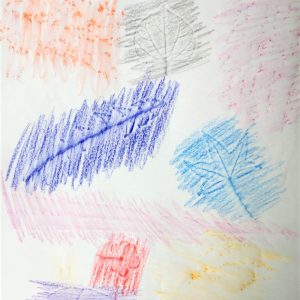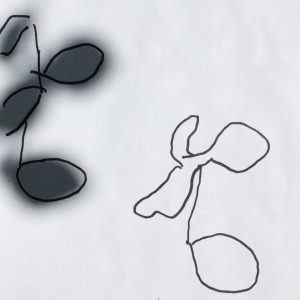Simple Nature Activities
Want to get your Vitamin N (nature)? Check out these nature-themed activities for all ages! Depending on the activity, these can be done at NCBG, home, school, or other outdoor space.
Note: Please remember when you visit NCBG to leave all flowers, leaves, seeds, sticks, rocks, and animals as you find them so that everyone can enjoy them. The Garden is their home; no picking or collecting.
Leaf or Bark Rubbings
Take a piece of paper, a crayon or colored pencil, and something hard and flat, like a book. Head outside and find an interesting plant. For bark rubbings, place the paper on the tree trunk and lightly color a section of the page revealing the texture of the bark. For leaf rubbings, put the leaf on your book or clipboard, and place your paper on top of both of them. Lightly color a section of the paper until you see the texture of the leaf appear. Do several on one piece of paper to create a collage of textures. How many textures can you discover?
Trace a Natural Object
Find a few natural objects such as leaves, flowers, and sticks. Trace each object on paper. Having someone hold the object while you trace may be easier. Some objects like leaves can be traced without removing them from their plant. What shapes do you see? What else do you notice?
Nature Mosaic
Gather natural materials such as clover, sticks, and pinestraw. (Remember to ask permission if gathering materials from places that are not your home.) Use your objects to create a nature mosaic or artwork. You can cut up an empty cereal or cracker box to give your artwork a sturdy foundation. Watch this video for more ideas from Jeannette Brossart, who created the mosaic mural in the Children’s Wonder Garden.
Shadows
Find an interesting shadow outside. If it is on pavement, trace it with chalk. Otherwise trace the shadow onto paper. Leave your paper there for a few minutes to watch the shadow move. Trace the shadow again. How far did the shadow move? Why did it move?
Make Binoculars
Make your own binoculars using empty toilet paper or paper towel tubes. Decorate the paper tubes. Then tape them together. Add string or yarn to be able to hang them around your neck. They will help you focus on the flowers, birds, and bees. What do you see?
Seed balls
Try a seed planting experiment. Using native plant seeds, plant some directly in the ground following the directions provided on the seed packet. Use some of the seeds, compost, and soil to make seed balls. Watch a brief video on how to make seed balls from Lady Bird Johnson Wildflower Center. After planting your seed balls, water all your seeds. Over time, which seeds grow the fastest? Which seeds grow into the biggest plants?
Paint with Soil
Grab some scrap paper. Mix small amounts of soil (less than a teaspoon) with a little water to use as your paint. Collect soil from a few different places to get different colors. Try using a stick, pine needles, a flower, or a leaf as your paintbrush. What picture will you paint with soil?
Nature Journal
Grab a notebook or fold some paper in half and start recording your nature observations. Draw and describe what you see. You can date your entries and include information about the weather and time of day. Choose a favorite spot to make observations from multiple times. Look closely at one small patch of ground. Pick a window from which to watch wildlife. What is your favorite way to observe nature?
Sound Map
Close your eyes and listen to the sounds around you. Focus on sounds close to you and then farther away. Make a map of what you hear by drawing what is making the sound. For example, you might draw a leaf to represent the sound of trees blowing in the wind. Draw a “you are here” star on the paper and then add what you hear in relation to where you are. How many sounds do you hear? How many sounds are nature sounds?
Plant Pigments
Rub a flower petal or leaf on a piece of paper to see what color pigment it contains. Pigments give plants their colors. How many shades of green can you find? Which ones surprised you? Which ones worked the best?
Bird Gym!
Scavenger Hunts
Enjoy your next outing at the Garden or other nature setting with these scavenger hunts!
Camouflage!
Learn about Buds
Citizen/Community Science
Kids are great observers, and they can be part of nature research.
What is citizen science? Here is a brief video introducing citizen at a kid-friendly level. Produced by University of Minnesota Extension.
Here are a few of our favorite citizen science projects for kids!
Budburst
Join NCBG in participating in Budburst’s Pollinators and Climate Project or choose one of their other projects. For the Pollinators and Climate Project, you are counting pollinators visiting a flowering plant. For their Phenology and Climate Project, you collect data on the stages of a plant, such as bud burst when the flower sepals have opened to reveal flower buds. For their Milkweeds and Monarchs project, you are observing monarch eggs and caterpillars on milkweed plants. Budburst projects are best suited for older children and teens or families working together.Cornell Lab of Ornithology
Find multiple bird related citizen science projects, including the Great Backyard Bird Count. Use eBird to collect all your bird watching data. Cornell’s Bird Academy offers courses, videos, games, and lectures to learn all about birds.ecoEXPLORE
ecoEXPLORE (Experiences Promoting Learning Outdoors for Research and Education) is an incentive-based citizen science program for children in grades K-8. Developed by The North Carolina Arboretum, this innovative program combines science exploration with kid-friendly technology to foster a fun learning environment for children while encouraging them to explore the outdoors and participate in citizen science. The ecoEXPLORE Facebook page also includes reminders, updates, and videos about the badges that are earned. The North Carolina Botanical Garden is an ecoEXPLORE Hotspot, which are special areas to make your observations.Science Across NC
Science Across NC is a collaboration of organizations, including the North Carolina Botanical Garden, offering quarterly events to get people outside and participating in research-based science. Earn badges for each event by collecting and submitting data. Along with how to participate in each event, the website lists corresponding programs across North Carolina.Seek by iNaturalist
This is an app for tablets and phones that uses iNaturalist data to identify wildlife. Kids can earn virtual badges as they photograph and identify species. They can be linked to an iNaturalist account or used by itself.

